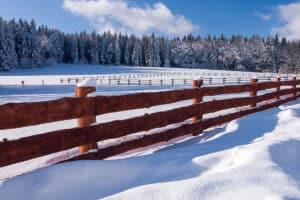A group of investors wanted to take advantage of RecLand being licensed in Texas by buying a tract of about 300 acres a few years ago. I was all for more action to help get our Texas business going. It was a nice mixture of planted pine timber with a large creek bottom with mature hardwoods and a beautiful bayou on the south boundary. It had access off a blacktop road and had deer, turkey and small game. It was our kind of tract.
The tract was just under an hour from Shreveport, Louisiana so it had a good population base to draw from for prospective buyers. We estimated that the tract should sell for near $2000 per acre. The group bought it with the expectation that they could sell it in three to four months on the market and make $300 to $400 per acre.
We used some tried and true improvement tricks and cleared a couple acres near the road for a camp or rural home site. We made two shallow water creek crossings with two loads of surge size rock. We used the dozer to clean out the existing trails in the pine and made a nice trail that meandered through the hardwood bottom. It was nice! We were ready to sell it.
We had a few calls and emails after the tract went on the market but not nearly the interest we expected. Months went by…still no serious buyers. At one point we noticed we weren’t getting any calls at all. It was priced right and a really nice property. What was wrong?
Well, I started investigating it some. First I found that the bridge was out on the main road – which came in from the Louisiana side – to get to the tract. The county was replacing the bridge and it would take about eight months for them to completely finish the project and re-open that part of the road.
You could get to the property from the Texas side but that was easier said than done. Come to find out, the roads leading to the property from the Texas side were small, rough roads that meandered for miles through timberland from the nearest Texas city about 45 minutes away. No one would choose to use that route if there was a better way.
The property was on the market for almost two years before we sold it for about a breakeven price. This is no good when you tie up money for no profit.
Here’s what I learned I did wrong:
1. I was wrong about the Shreveport market area being our source of buyers. I was trying to sell Texas hunting land – with a more restrictive hunting season and tighter regulations – to Louisiana hunters who were used to more generous deer harvest limits and who didn’t want to buy non-resident licenses. The Texas population of potential buyers was very limited since it was a much longer and tougher drive from the populated areas on the Texas side.
Lesson: Know your market and most likely source of potential buyers before you make the deal. Just because this tract was just six miles from a Louisiana town and 45 minutes from a large Louisiana population, it was still a Texas property. I missed the relevance of that.
2. I didn’t drive the overall area before buying the tract to see more of what it looked like coming from the Texas side. If I would’ve done this, I may have caught the population problem since I would’ve seen how difficult it was for people in the Longview, Tyler and Marshall areas to get to the property. We wouldn’t have normally known about the coming bridge project but we should have explored all the access points.
Lesson: If you’re in a new area, drive it. Take a look at the area from the perspective of your potential buyers. Try to see the property the way the market will see it. I can’t emphasize this point too strongly for a rural property. This may have been the key element and I totally missed it because even though I didn’t know the area well I NEVER once came into the property from the Texas side! What a mistake.
3. I was too anxious to get more Texas business going so I probably just saw all the positive things because I just wanted to do the deal.
Lesson: A deal has to stand on its own legs. A marginal deal doesn’t get better just because you really, really, really want to do it. Fighting the emotional part of real estate is always a battle – and it’s especially hard when you deal with gorgeous land tracts like we do – but the real pros know how to set their personal preferences aside and evaluate all the components of the deal to see if it’s clearly worth the time, money and risk.
This preceding article is an excerpt from Pat Porter’s book, “Land Mines: Lessons to Keep Your Rural Real Estate Deals from Blowing Up”, Chapter 7: Right Property – Wrong Place. Deals are sometimes loaded with land mines that can blow up and cause you serious problems, time delays and a loss of money. This book highlights some mistakes and near misses Pat has personally made in land deals that will teach you some important lessons. The lessons this book includes – though illustrated through actual land deals – can be expanded across all types of real estate and can help you regardless of your role in the deal – buyer, seller or agent. Get the audio book today.
This content may not be used or reproduced in any manner whatsoever, in part or in whole, without written permission of LANDTHINK. Use of this content without permission is a violation of federal copyright law. The articles, posts, comments, opinions and information provided by LANDTHINK are for informational and research purposes only and DOES NOT substitute or coincide with the advice of an attorney, accountant, real estate broker or any other licensed real estate professional. LANDTHINK strongly advises visitors and readers to seek their own professional guidance and advice related to buying, investing in or selling real estate.










Add Comment